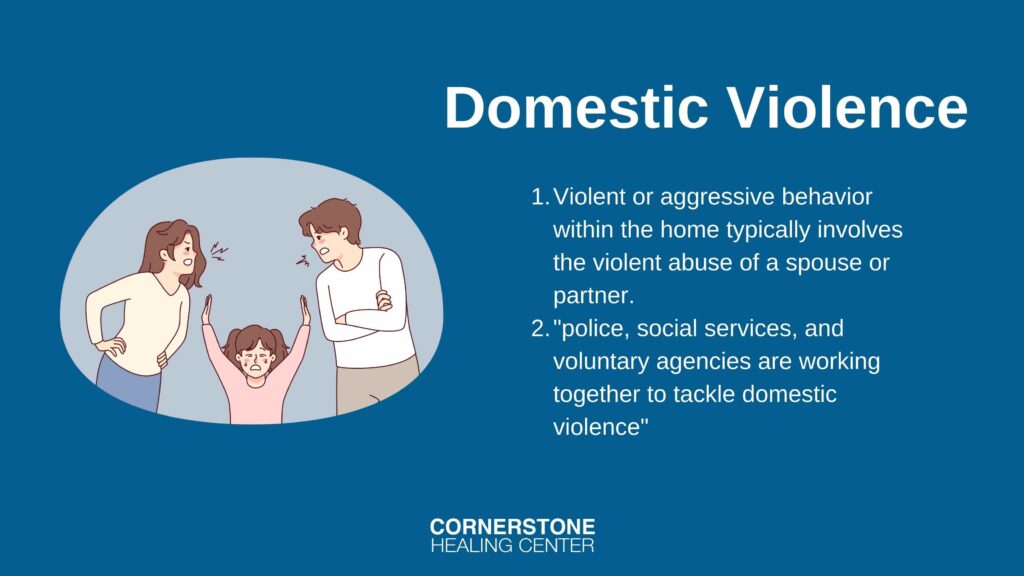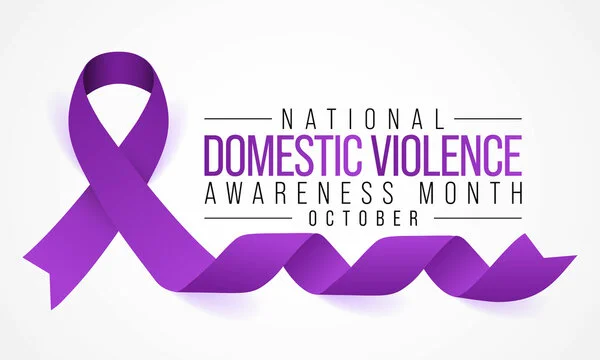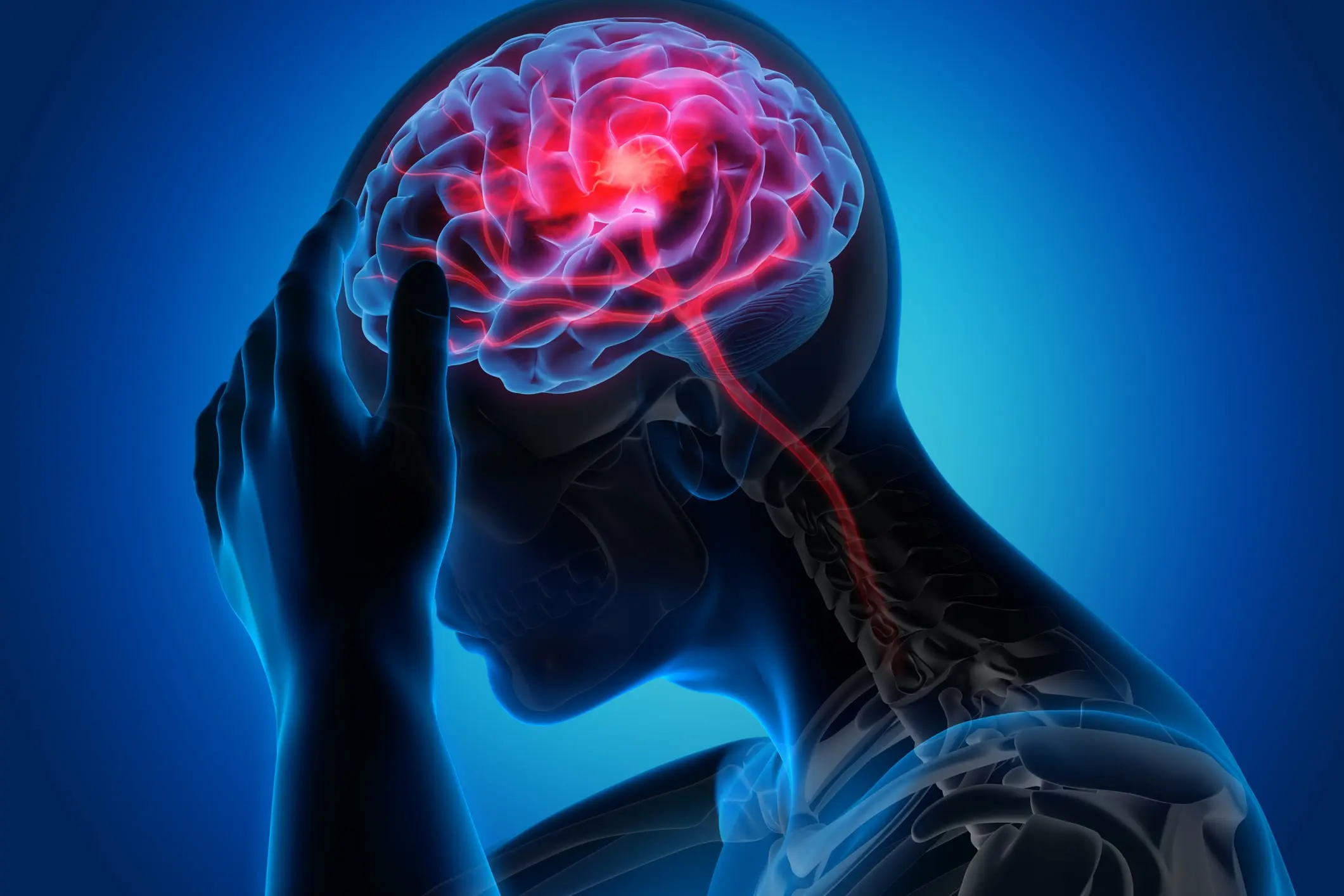During the month of October, communities and organizations across the globe come together to raise awareness about domestic violence.
This month is dedicated to shedding light on the pervasive issue of domestic violence, affecting millions regardless of age, race, or socioeconomic status.
Let’s explore the intricate and often overlooked connection between domestic violence and addiction, delving into how these two devastating issues are intertwined and impact the lives of victims and their families.
By understanding this complex relationship, we hope to contribute to the ongoing dialogue and find effective strategies and interventions that can help break the cycle of abuse and provide hope and healing to those affected.

The Importance of Domestic Violence Awareness Month
October is Domestic Violence Awareness Month, which serves as an essential time for raising awareness and promoting the prevention of domestic violence, a pervasive issue affecting millions worldwide.
The observance began in 1981 as the “Day of Unity” organized by the National Coalition Against Domestic Violence and expanded to a month of activities, education, and remembrance in 1987.
Intimate partner violence affects more than 10 million men and women annually in the United States, with almost 20 people physically abused by their partners every minute.
During Domestic Violence Awareness Month, numerous organizations, communities, and individuals participate in events such as candlelight vigils, educational workshops, and awareness-raising campaigns.
These initiatives are vital in honoring the 1 in 4 women and 1 in 9 men who experience severe intimate partner physical violence, sexual violence, or stalking, which can cause injury, fearfulness, post-traumatic stress disorder, and even death.
Additionally, there is a clear link between domestic violence and addiction.1
Studies show that women in abusive relationships are 70% more likely to abuse alcohol.
Stress and trauma resulting from domestic violence may lead individuals to seek solace in substances, creating a vicious cycle that exacerbates both issues.
Conversely, addiction can fuel aggressive and violent behaviors, further entrenching the patterns of abuse.
This connection highlights many dual challenges and the urgent need for integrated support and intervention.
Focusing on domestic violence and addiction during Domestic Violence Awareness Month can create a more holistic and supportive network for victims, fostering an environment conducive to healing and empowerment.

Understanding Domestic Violence
Types of Domestic Violence:
| Type of Abuse | Details |
|---|---|
| Physical Abuse | Involves using physical force against the victim, causing injury or harm. Examples include hitting, slapping, punching, kicking, or using a weapon. |
| Emotional Abuse | Involves manipulating and controlling the victim through verbal assault, intimidation, and constant criticism, leading to diminished self-esteem and sense of worth. |
| Sexual Abuse | Involves forcing the victim to engage in sexual activities without their consent. It includes sexual assault, rape, and any form of non-consensual touching or coercion. |
| Financial Abuse | Involves controlling the victim’s financial resources, stealing or withholding money, and limiting their access to financial independence. |
Effects on Victims
Physical Effects:
Beyond the immediate injuries, victims of domestic violence can experience a range of physical health issues, including chronic pain, gastrointestinal disorders, sexually transmitted diseases, and sleep disturbances.
Pregnant women face additional risks, such as miscarriage, pre-term labor, or low birth weight.2
Psychological Effects:
The mental health impact on victims can be severe, including anxiety, depression, post-traumatic stress disorder (PTSD), and suicidal thoughts or actions.
Many victims also suffer from low self-esteem, feelings of worthlessness, and persistent fear.
Profile of Perpetrators
Perpetrators of domestic violence often share common characteristics, although it is crucial to note that abusers can come from all walks of life.
They may exert power and control over their victims through various forms of abuse.
Many have witnessed or experienced violence in their own homes, have substance abuse issues, or demonstrate manipulative and controlling behaviors.
It is important to understand these traits not as justifications for their actions but as risk factors that can contribute to the cycle of violence.
Societal Impact of Domestic Violence
Domestic violence has a profound impact on society.
It strains community resources, decreases work productivity, and raises healthcare costs.
Children who witness domestic violence are at an increased risk of developing emotional, behavioral, and psychological issues, and they are more likely to perpetuate the cycle of violence in their relationships.
The pervasive nature of domestic violence also contributes to normalizing violence, undermining social values, and eroding community bonds.
Addressing domestic violence requires a concerted effort from individuals, communities, and institutions to create a cultural shift that condemns violence and promotes healthy, respectful relationships.
Understanding Addiction
Types of Addictions
Substance Abuse (alcohol, drugs):
This refers to the excessive use of substances such as alcohol, prescription medication, and illicit drugs.
It can lead to addiction, a chronic, relapsing disorder characterized by compulsive drug seeking, continued use despite harmful consequences, and long-lasting changes in the brain.
Behavioral Addictions (gambling, sex):
Unlike substance addiction, behavioral addictions do not involve ingesting a substance.
Instead, they focus on compulsive engagement in rewarding non-substance-related behavior.
Examples include gambling addiction, where the person cannot resist the urge to gamble despite negative consequences, and sex addiction, characterized by compulsive participation or engagement in sexual activity, even when it becomes harmful.
Causes of Addiction:
| Factors | Description |
|---|---|
| Genetic Factors | Genetics can play a role in an individual’s susceptibility to addiction, with certain genetic traits possibly being passed down through generations. |
| Environmental Factors | Includes influences like family background, social circle, accessibility to substances, and socioeconomic status, all of which can contribute to addiction. |
| Psychological Factors | Involves aspects like mental health conditions, personality traits, and coping mechanisms, which can all influence addiction patterns. |
Effects on Individuals
Health Effects:
Depending on the type of addiction, addiction can lead to various short- and long-term health effects.
For substance addictions, these can range from changes in appetite, sleep disturbances, cardiovascular issues, stroke, and infectious diseases.
Behavioral addictions can also have significant health effects, including physical strain, sleep problems, and neglect of personal health.
Social and Relationship Effects:
Addiction can lead to strained relationships, impacting a person’s connection with family, friends, and colleagues.
It can also contribute to social isolation, job loss, and financial difficulties.
The individual’s behavior while addicted can cause damage to their reputation and result in a loss of trust among loved ones.
Societal Impact of Addiction
Addiction carries significant societal costs, including increased healthcare expenses, lost productivity, and additional burdens on the criminal justice system.
Substance abuse alone costs society over $600 billion annually.3
The ripple effect of addiction contributes to community instability, increased violence, and decreased quality of life.
Furthermore, a societal stigma attached to addiction can prevent individuals from seeking help, exacerbating the problem.
Effective prevention, treatment, and recovery services can mitigate the impact of addiction on society, highlighting the importance of addressing this issue comprehensively.

The Link Between Domestic Violence and Addiction
How Addiction Can Lead to Domestic Violence
Addiction can act as a significant catalyst for domestic violence, with substances like alcohol and drugs often playing a role in escalating aggressive behavior.4
The impairing effects of substances can lower inhibitions, impair judgment, and increase the propensity for violence, making the home an unsafe environment.
The need to acquire substances can lead to financial stress, often resulting in conflict and violence.
As addiction consumes an individual’s life, their relationships deteriorate, making intimate partners particularly vulnerable.
The frustration and anger stemming from an inability to control the addiction can also be misdirected toward the partner, increasing the likelihood of domestic violence.
How Domestic Violence Can Lead to Addiction
Conversely, victims of domestic violence are at a higher risk of turning to substances as a coping mechanism.
The trauma experienced from ongoing abuse can lead to mental health disorders such as anxiety, depression, and PTSD, which individuals may attempt to self-medicate with alcohol or drugs.
This attempt to numb the pain or escape from the reality of their situation can quickly spiral into addiction, creating a dual crisis of violence and substance abuse.
Moreover, abusers may also coerce or force their victims to use substances, directly contributing to the development of an addiction.
The Cyclical Nature of Domestic Violence and Addiction
The relationship between domestic violence and addiction is inherently cyclical and mutually reinforcing.
Addiction can lead to domestic violence, which can result in substance abuse by the victim.
This vicious cycle creates an environment of continuous instability and danger, with each issue exacerbating the other.
The chaos and trauma that result from this cycle make it incredibly challenging for victims to seek help and for abusers to break free from their violent behaviors.
Recognizing this interconnection is crucial for providing comprehensive support and intervention, aiming to disrupt the cycle and offer paths toward recovery and safety.
Case Studies
Numerous real-life examples and case studies highlight the tragic interplay between domestic violence and addiction.
One notable case involved a woman who, after years of enduring physical and emotional abuse at the hands of her alcoholic husband, developed a severe alcohol addiction.
The husband’s drinking often led to violent outbursts, and the woman started drinking heavily in her desperation to cope.
This case illustrates the complex dynamics of this interconnection, showing how both parties were trapped in a cycle of violence and addiction.
Intervention in such cases requires addressing both issues concurrently, providing support for substance abuse recovery, and ensuring safety and counseling for the domestic violence victim.
Taking an integrated approach makes it possible to break the cycle and offer hope for a violence-free and addiction-free life.
Common Substances and Behaviors Linked to Domestic Violence
Substances Most Commonly Associated with Domestic Violence (e.g., Alcohol, Drugs)
Alcohol and illicit drugs are the substances most commonly associated with domestic violence.
The consumption of alcohol, in particular, has been closely linked to an increase in aggressive behavior and violence within intimate relationships.5
This is due to its impairing effects, which can reduce inhibitions, impair judgment, and increase impulsivity, making violent outbursts more likely.
Illicit drugs, such as cocaine and methamphetamine, can also contribute to domestic violence due to their stimulating effects, leading to heightened aggression.
Cannabis, although generally considered a depressant, has mixed associations with domestic violence, with some studies suggesting a link while others do not.
How Addiction to These Substances Can Lead to Violent Behavior
Addiction to substances like alcohol and drugs can lead to violent behavior through various mechanisms.
The physical and psychological dependence on these substances can increase stress, irritability, and frustration, especially during withdrawal.
Individuals addicted to these substances might also engage in violent behavior to obtain money or drugs.
Additionally, the chronic use of these substances can lead to neurological changes that increase aggression and reduce impulse control.
For example, long-term alcohol abuse can damage areas of the brain responsible for judgment and impulse control, leading to a higher likelihood of violent behavior.
The Role of Behavioral Addictions (e.g., Gambling, Pornography) in Domestic Violence
Behavioral addictions, such as gambling and pornography addiction, can also play a role in domestic violence, though the dynamics might be different from substance addictions.
With gambling addiction, the financial strain and debt stress can lead to frustration and aggression, which may be taken out on a partner.
The secrecy and shame associated with pornography addiction can create emotional distance and mistrust in a relationship, potentially escalating to verbal or physical abuse.
Additionally, consuming violent or aggressive pornography can normalize such behavior, potentially translating to real-life aggression towards a partner.
Addressing these behavioral addictions is crucial in preventing domestic violence and maintaining healthy relationships.
Addressing Domestic Violence and Addiction Together
The Need for Integrated Treatment
Combating the intertwined issues of domestic violence and addiction necessitates a comprehensive and integrated approach, ensuring that both the addiction and the effects of domestic violence are addressed simultaneously, providing a holistic approach to recovery.
Victims and perpetrators need access to comprehensive services that address both issues concurrently.
For victims, this could mean safe shelters that provide or refer out for substance abuse counseling.
Accountability programs that address violent behavior alongside addiction treatment may be necessary for perpetrators.
Encouragingly, many communities have hotlines, counseling services, and support groups specifically designed to assist those dealing with these co-occurring issues.
Healthcare providers, therapists, and social workers trained in trauma-informed care can offer invaluable support and resources to guide individuals toward recovery.
Emphasizing the importance of safety, establishing trust, and creating an individualized plan that addresses both the addiction and the experience of domestic violence is paramount.
With the right support and resources, individuals facing these challenges can embark on a path to recovery, healing, and a life free from violence and addiction.
Strategies for Preventing Domestic Violence and Addiction
To effectively prevent domestic violence and addiction, it is vital to adopt a proactive and multifaceted strategy.
This includes raising public awareness about the signs and implications of domestic violence and addiction, as well as promoting education on healthy relationships and coping mechanisms from a young age.
Community-based programs can play a significant role in providing resources and support to at-risk individuals.
At the same time, law enforcement and healthcare professionals require ongoing training to respond appropriately and provide necessary interventions.
Creating and enforcing stricter legal penalties for perpetrators of domestic violence, alongside accessible rehabilitation programs for those struggling with addiction, can contribute to a safer society.
By fostering a culture of support, awareness, and accountability, it is possible to mitigate the prevalence of domestic violence and addiction, paving the way for healthier communities.
Challenges in Addressing Both Issues
Addressing the intertwined issues of domestic violence and addiction is a complex task as they are deeply rooted in various social, psychological, and systemic factors.
Both victims and perpetrators face significant challenges in seeking help and participating in necessary accountability and treatment programs.
The cyclical nature of both issues further complicates intervention efforts, as each can perpetuate the other, creating a daunting barrier to effective resolution.
Moreover, the lack of integrated treatment programs that address both domestic violence and addiction concurrently can hinder individuals’ path to recovery, leaving them with incomplete or inadequate support.
Hence, it is crucial to ensure that professionals across various sectors are adequately trained in trauma-informed care and understand the unique needs of those affected by both domestic violence and addiction.
Unraveling The Impact on Victims
The Physical and Emotional Toll on Victims of Domestic Violence and Addiction
Victims of domestic violence and addiction face profound physical and emotional challenges.
Physically, they may suffer from violence-related injuries, such as bruises, fractures, or more severe conditions requiring medical attention.
They are also at an increased risk of developing health issues related to stress and trauma, including chronic pain, gastrointestinal disorders, and reproductive issues.
Emotionally, victims often experience anxiety, depression, and post-traumatic stress disorder (PTSD), as the constant state of fear and hyperarousal takes a toll on their mental well-being.
Whether it is their own or their partner’s, addiction exacerbates these challenges, adding complexity to their trauma and recovery process.
They may feel trapped in the cycle of violence, with substances acting as a misguided form of coping or escape, further deepening their sense of helplessness and isolation.
The Barriers That Prevent Victims From Seeking Help
Various barriers prevent victims from seeking help, including fear of retaliation from the abuser, economic dependence, and the stigma attached to domestic violence and addiction.
Victims may fear that reporting the abuse will lead to increased violence or that they will not be believed.
Cultural and societal norms may also play a role, as some communities might stigmatize divorce or separation, pressuring victims to stay in abusive relationships.
The lack of awareness about available resources and support systems further complicates the situation, leaving victims feeling isolated and unsure where to turn.
In addition, when addiction is involved, there may be a fear of legal repercussions, such as losing custody of children or facing charges related to substance abuse.
These barriers underscore the importance of creating safe, accessible, and non-judgmental support services for domestic violence and addiction victims.
Overcoming Domestic Violence and Addiction
As we take a moment to reflect on Domestic Violence Awareness Month, it becomes clear that shining a light on the relationship between domestic violence and addiction is crucial.
This dedicated time is a powerful reminder of the urgent need to tackle these intertwined issues head-on.
It is important to provide education, resources, and support to those affected, fostering a culture of awareness and compassion.
By doing so, we can break the cycle of violence and addiction, paving the way for healing and recovery.
To those currently struggling with these challenges, please know that you are not alone, and help is available.
Seeking support is a sign of strength, and with the right resources and a supportive community, a brighter, safer future is within reach.
The journey towards healing may be difficult, but it is worth taking.
It leads to empowerment, resilience, and the reclamation of one’s life.
If you are struggling with addiction, please get in touch with us at Cornerstone Healing Center in Scottsdale, AZ.
Our facility is centered around trauma-focused addiction treatment, emphasizing holistic healing to foster enduring recovery and a transformative journey toward wellness.
SOURCES
Cornerstone Healing Center – Scottsdale Drug Rehab Arizona
National Resource Center on Domestic Violence
National Domestic Violence Hotline
[1] Intimate partner violence and drug-addicted women: from explicative models to gender-oriented treatments
[2] Domestic violence against pregnant women is a potential risk factor for low birthweight in full-term neonates: A population-based retrospective cohort study
[3] NIH Report
[4] Alcohol, Aggression, and Violence: From Public Health to Neuroscience
[5] Alcohol-Related Aggression—Social and Neurobiological Factors
Published: 10/30/2023
Contributor: Julie Miller
Editor: Susana Spiegel








